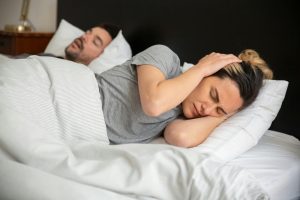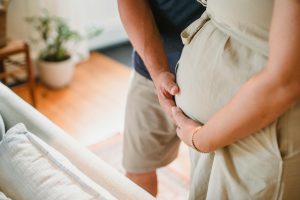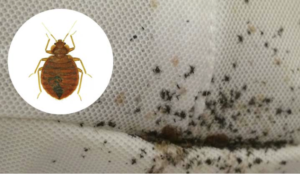BED BUGS MOLD ON MATTRESS
If you’ve ever woken up to discover small, reddish-brown bugs crawling on your sheets and mattress, you may have a bed bug infestation.
Unfortunately, these pests aren’t the only problem you may have to deal with. Bed bugs can create the perfect environment for mold growth on your mattress, which can lead to a host of health problems.
In this article, we’ll discuss the difference between bed bugs and mold and the dangers of bed bug mold on your mattress, how to identify it, and what steps you can take to get rid of it for good.
So, if you’re tired of losing sleep over bed bugs and mold, read on to learn more.
Table of Contents
Understanding Bed Bugs And Mold
What Are Bed Bugs?
Bed bugs are small, oval-shaped, reddish-brown insects that feed on the blood of humans and animals while they sleep. They are wingless and have flat, oval-shaped bodies that can grow up to about the size of an apple seed.
Bed bugs are mostly active at night and can hide in cracks and crevices during the day, making them difficult to detect and eliminate. They typically live in and around beds, but they can also be found in other areas of the home, such as couches, chairs, and carpets. Since they easily travel from one location to another by hitchhiking on clothing, furniture, or luggage, they are often found in hotels, homes, and other places where people sleep or rest.
It is important to note that bed bugs do not transmit diseases, but their bites can cause itching, redness, swelling, and irritation. A bed bug infestation can be difficult to control and often requires professional extermination services.
What Is Mold?
Mold, on the other hand, is a type of fungus that grows in damp, humid environments. It can appear as black, green, or white spots on a variety of surfaces, including walls, ceilings, and mattresses. Mold can cause respiratory problems, allergic reactions, and other health issues such as infections, irritations, headaches, fatigue, and can lead to neurological symptoms in very rare cases.
Bed Bug Mold On Mattress
When bed bugs and mold combine on a mattress, it can create a dangerous situation. Not only can mold exacerbate respiratory problems, but it can also attract bed bugs, making it more difficult to get rid of them.
Causes Of Bed Bug Mold On Mattress
Understanding what causes bed bug mold is the first step in addressing it and getting rid of it. Bed bug mold on a mattress can be caused by a variety of factors, including:
High Humidity
When the air in a room is humid, moisture can collect on surfaces like a mattress, creating an environment that is conducive to mold growth. Using a dehumidifier or running the A/C can help dramatically decrease the air moisture in your room. The U.S. Consumer Product Safety Commission recommends humidity levels in bedrooms to be maintained between 30% and 50%. Anything above 60% will give mold the perfect ground for growth.
Water Damage
If a mattress has been exposed to water (i.e., from a leaky roof, a spill, accident in kids’ room, etc.) it can create a damp environment that encourages mold growth. After such event, ensure that you fully dry out your mattress – remove all sheets and let your mattress fully dry before laying new sheets. If you are able to put your mattress in the sun, it would be a great way to naturally sanitize your mattress. We also always recommend the use of a waterproof mattress protector to protect your mattress investment.
Poor Ventilation
When a room lacks proper ventilation, moisture can build up and create conditions that are favorable for mold growth. If you live in dry climate, give your room a quick dose of fresh air by opening all windows (even in the winter) for a few minutes just as you wake up. Make sure you pull your blanket back to allow the whole mattress to dry after your night of sleep.
Signs Of Bed Bug Mold On Mattress
If you suspect that you have bed bug mold on your mattress, have a good look at it. There are several signs to look out for, including:
Visible Mold Growth
This is the easiest to spot as it is visible and easy to see with your bare eyes. Visible mold growth may appear as black, green, or white spots on your mattress. It will usually be your first alerting sign.
Musty Odor
Mold has a distinct musty smell that can be easily detected. Many will also have an adverse reaction when smelling mold – a feeling of scratchy throat, needing to get rid of an itch or something in the throat…
Bed Bug Infestation
If you have a bed bug infestation, there is a higher likelihood that mold will grow on your mattress due to the presence of moisture from bed bug feces and saliva.
How To Prevent Bed Bug Mold On Mattress
If you can avoid bed bug mold on your mattress, please do. Getting rid of them, once infested, can be challenging and will often require the help of a professional, and usually results in discarding of the mattress.
Preventing bed bug mold on a mattress requires a combination of proactive measures, including:
Regular Cleaning
Always protect your mattress with a mattress protector, to reduce the dust, moisture, hair and skin cells deposits on your mattress. Keep your bedroom and mattress clean by vacuuming and dusting regularly, as well as keeping clean sheets.
Proper Ventilation
Ensure that your bedroom has adequate ventilation by opening windows or using a fan. If you live in a dry area, start your day by propping your bedroom windows open, after having pulled your comforter down to give your mattress proper ventilation and fresh air. This will recycle the air in your bedroom while drying your bedroom air and mattress. If you make your bed for the day, try folding your comforter down in order to air at least the top half of your mattress for most of the day.
Reduce Bedroom Humidity
Mold strives in humid and warm conditions! Use a dehumidifier to reduce humidity levels in your bedroom, especially if you notice the air being around, or above 60% humidity. Aim for 30% to 50% humidity levels if possible. Running the A/C will also bring your bedroom humidity down, making it harder for bed bugs and mold to thrive.
Address Water Damage
If your mattress has been exposed to water or other liquids, address the damage immediately to prevent mold growth. Pull the sheets immediately and if you are able, lay the mattress in the sun to dry faster and naturally sanitize the stain. Do not put sheets back on until the mattress has fully dried. Using a waterproof mattress protector will ensure you limit the risks of wetting the mattress itself.
Treat Bed Bug Infestations
If you have a bed bug infestation, it is important to treat it promptly to prevent the buildup of moisture and the growth of mold. Hire a professional to come treat your home, especially as bed bugs could have invaded other areas of your house, including couches, chairs, clothing, etc.
How To Remove Bed Bug Mold On Mattress
If you discover bed bug mold on your mattress, take immediate action to remove it. We recommend hiring a professional, but if you would like to give it a go on your own first, here’s how:
Wear Protective Gear
Put on a mask, gloves, and goggles to protect yourself from mold spores. You want to protect your lungs and avoid inhaling the mold, especially as it becomes airborne.
Vacuum The Mattress
Using a vacuum with a HEPA filter, remove any visible mold spores and bed bugs you may see. Unfortunately, it is generally accepted that a mattress infected with bed bugs, will need to be thrown away.
Use A Mold Remover
Apply a mold remover to the affected areas of the mattress, following the manufacturer’s instructions carefully.
Dry The Mattress
Allow the mattress to dry completely before using it again. If possible, lay the mattress in the sun. Sunning will naturally lift stains, as well as sanitize your mattress, helping you better get rid of remaining mold.
Dispose Of The Mattress
If the mold is extensive or the mattress is severely damaged, it may be best to dispose of the mattress and purchase a new one. If you have bed bugs on it, this may unfortunately be your only option, as getting rid of bed bugs is nearly impossible.
Bed Bug Mold On Mattress
Finding bed bug mold on a mattress can be a serious problem. Not only can it cause unpleasant odors and stains, but it can also lead to health issues such as respiratory problems, allergic reactions, or more severe symptoms for those dealing with asthma and other conditions.
It is important to address bed bug and/or mold promptly by hiring a professional exterminator to eliminate the bed bugs and clean and sanitize the affected area. Thankfully, proper mattress maintenance and regular cleaning can help prevent the growth of mold and the infestation of bed bugs. Things like airing and vacuuming the bedroom, maintaining a healthy temperature and humidity level, and ensuring your mattress remains dry and clean, can help in preventing problems before they arise.
By taking these steps, sleepers can ensure a clean and healthy sleeping environment for themselves and their families.
FAQ
Most frequent questions and answers
Bed bugs are visible. Check your mattress for small oval-shaped brown bugs, small or up to the size of an apple seed. If they are in your mattress, check other upholstery in your home.
Thankfully, bed bugs do not spread disease. Their bite can however cause itching, redness, swelling, and irritation.
You will see and/or smell the mold on your mattress. It can appear as black, green, or white spots and tends to grow in moist and war environment.
Keep your bedroom air between 30% and 50% humidity and ensure to air it often. Use a waterproof mattress protector and dry any wetness that may get onto your mattress.
More Sleep Resources

Understanding Sleep Apnea Symptoms in Women Over 50
UNDERSTANDING SLEEP APNEA SYMPTOMS IN WOMEN OVER 50 Recognizing Signs and Seeking Solutions Sleep apnea is a common sleep disorder characterized by pauses in breathing

How to Stop Snoring Without Surgery
HOW TO STOP SNORING WITHOUT SURGERY Effective Strategies for Quieter Nights Snoring is a common sleep disturbance that affects millions of men and women worldwide,

7 Tips To Improve Sleep Hygiene For Shift Workers
7 TIPS TO IMPROVE SLEEP HYGIENE FOR SHIFT WORKERS Strategies for Rest and Well-Being Shift work has become an integral part of many industries, with

5 Tips for Better Sleep During Pregnancy
5 TIPS FOR BETTER SLEEP DURING PREGNANCY Essential Strategies for Expectant Mothers Pregnancy is a beautiful journey filled with excitement and anticipation, but it can
How is sleepwalking diagnosed?
It is generally easy to diagnose sleepwalking if the sleeper lives with family members or roommates who notice the unusual nighttime activity associated with sleepwalking.
Can sleepwalking be treated?
While no drug exists to treat sleepwalking, the condition is usually a symptom of external cause or an underlying condition. Treating the condition first will often result in getting rid of sleepwalking.
Who is at risk for sleepwalking?
Children are most at risk of sleepwalking. Though a genetic factor seems to exist, making children of sleepwalking parents more likely to sleepwalk. Adults can also start sleepwalking and should consult a doctor to understand the underlying cause.
What safety precautions should be taken for someone who sleepwalks?
If the sleepwalker is a child, it is important to set door and window alarms, add stair gates, avoid using bunk beds, or even maybe an indoor movement detector if this is a young child. For adults, the risk is with walking out of the door, cooking, driving. An indoor alarm and door/window alarm can help too.
Share this deal with a friend!

Laura Georgieff
Laura is a mother of three who did not sleep through the night for the first 5.5 years of her kids' lives. She is passionate about sleep quality and loves sharing her experience and knowledge of all thing bedding! It is her mission to help you make the best decisions when it comes to sleep and help you get the best deal on the market!


